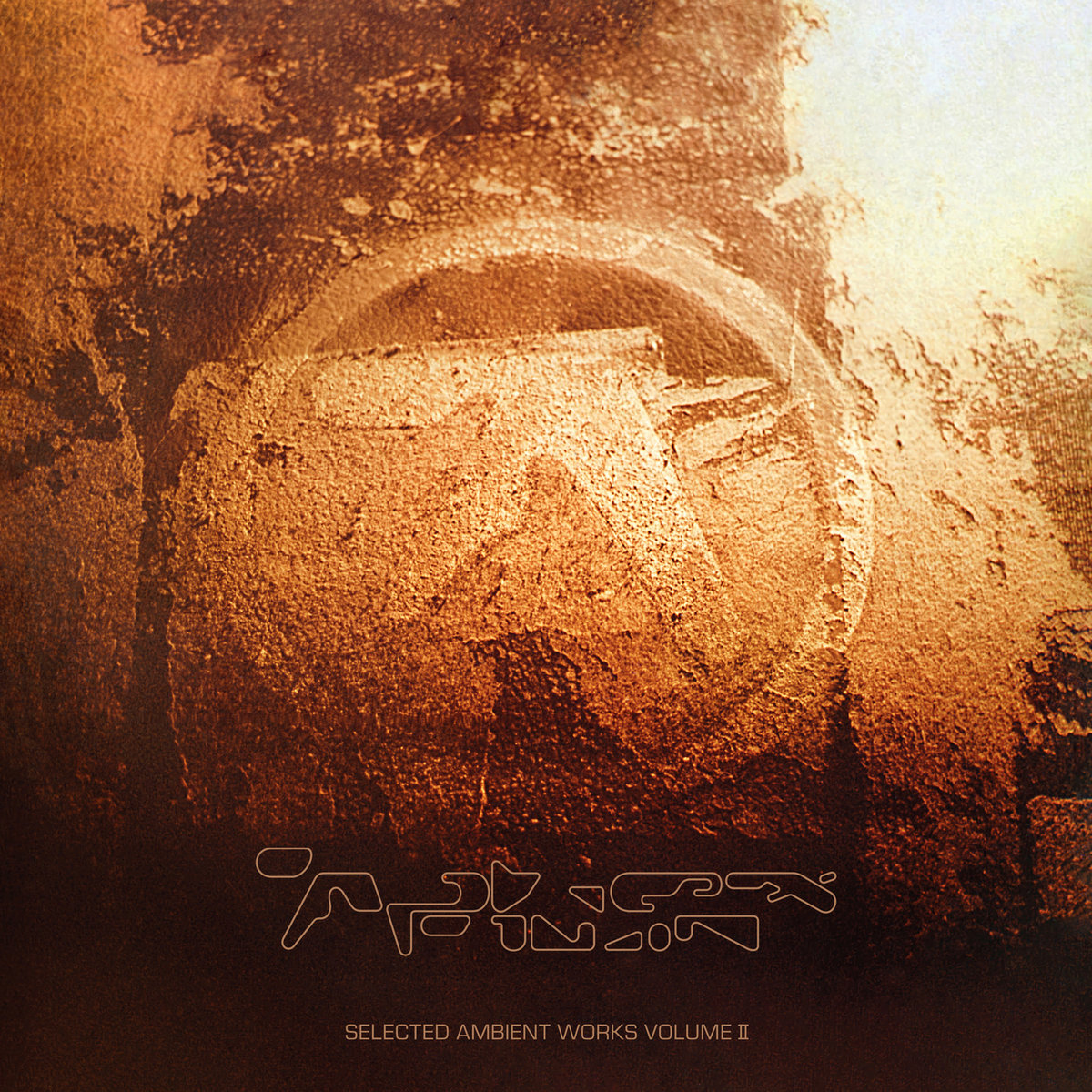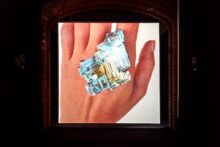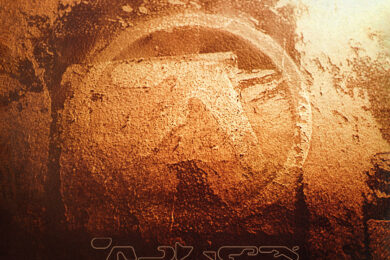“Chilling out for me is getting [smashed] out of your head, sitting somewhere totally wasted basically. SAW2 is the stuff I prefer to listen to. I just get more into tracks like that.”
Richard D James, Mixmag, 1995
“Heightened senses, telepathy, huge increase of smell. I think I can smell my own brain now… it smells clean and grey, it’s a strange smell… I think doing acid is a bit of a brute force way of getting outside yourself. I had an astral projection the first time I did acid – after about five or six hours – right outside myself on the ceiling. [I] looked down on my body making a sandwich. [It was] such a terrifying experience.”
Richard D James, Syrobonkers interview, 2014
“Come on you cunt, let’s have some Aphex acid”
Aphex Twin – ‘Cock/ver10’, Drukqs, 2001
The release of the second volume in the Selected Ambient Works series on 7 March 1994 by electronic musician Richard D James working under his primary artistic alias Aphex Twin seemed to bring with it an act of mass hypnosis. An enforced weakness to suggestion combined with a dulling of peripheral sensory awareness would explain why so many people were initially quick to suggest that this was a formless, rhythmless, vaporous mist of reverb, spectral synth pads, echo and static. More absence than presence. And it wasn’t just music journalists and punters. Rob Mitchell, who was responsible for signing Aphex Twin to Warp – according to RDJ himself at least – was refreshingly direct on first hearing the new tracks: “Rob was funny AF. I remember when I gave him SAW2, he hadn’t heard any of the tracks before and [he] was straight on the phone going, ‘WTF is this? It’s just some synths with tons of reverb on it?’ LOL, I like cheeky opinions like this.”
Rob Mitchell was joking of course… but perhaps only to a certain degree, and the idea that listening to this album was akin to ending up becalmed in a complex FX chain ocean did look set to become the dominant narrative. But today the quantized pulse of ‘Blur’ [#8] and ‘Weathered Stone’ [#9]; the heavy groove of ‘Windowsill’ [#18] & ‘Lichen’ [#20] and the outright crunching thump of ‘Shiny Metal Rods’ [#15] are so very clearly audible as a form of new electronic music, it makes you wonder exactly when this particular spell was broken.
The album’s status as one of the first major releases to be anticipated by, reviewed by and obsessed over in intense detail by an online community, was pointed out retrospectively but astutely by Mark Richardson of Pitchfork, referring to the importance of the then-new, genre-coining IDM email list. Their hive-mind analyses were smart enough to reveal structural flaws in mainstream music reviewing. They also showed certain famous critics as being ever more out of their depth, when they compared this unfavourably to the ambient work of Brian Eno (who of course had the rock crit stamp of approval) and likewise to Steve Reich (who came with academic bona fides). Same as it ever was. But the stunning thing was how quickly the work of a dynamic online community could wrest the narrative from hidebound hands. (Strictly speaking SAW2 had “mixed” reviews. For every Christgau misfire, there was a smart cookie Reynolds to point out this was no mere come down anxiety balm.)
The id-scrambling “noise” of Stravinsky’s Rite Of Spring may not have caused an actual riot at its Parisien premiere but it’s safe to say that it was largely hated and did not reveal its actual musicality to any kind of audience for many generations to come. The once vanguard of near unlistenability in heavy metal, Slayer’s four decade old Reign In Blood has, more recently, entered the primary stages of habilitation but is still nowhere near face-scrubbed enough to rub shoulders at the top table with London’s Calling and Revolver. SAW2, however, revealed that the game of lengthy cultural decompression with conservative gatekeepers at the controls might essentially be up; while also making it clear the extent to which online fan communities would call the shots in future. The complete story of how list member Greg Eden, kept an exhaustive Aphex Twin discography and gave each of these tracks a descriptive name based partially on the highly textural, loose-focused photographic idents attached to each one and his own intuition, is recounted fully in Marc Weidenbaum’s essential 33 ⅓ compact book on the album, and doesn’t need to be recounted here. An idea that is yet to be fully explored however is just how Cornish this album is. Or rather, how this album is a representation and appreciation of the material substance of Cornwall as experienced on LSD.
‘Blue Calx’ is, probably, the oldest track on the album, was recorded in 1992 and appeared on the compilation The Philosophy Of Sound And Machine in October of that year [attributed to RDJ’s short lived Blue Calx name], several months before SAW85-92 was even released. This is interesting because it means it was recorded entirely in his childhood home of Linmiri, specifically in the heavily mythologised and romanticised bedroom studio he christened Lannerlog. On top of the bonus of this homebrew studio and audio research lab being rent-free, it afforded him epic views over the rural West Cornish Lanner district, specifically the striking rocky outcrop of Carn Marth. (Aphex Twin expert Mark Cartwright of the Lanner Chronicle, has theorised quite convincingly that most, if not all, of this album could have been recorded in 1992.) This immediately calls into question the idea of this album being part of urban chill out room culture. The album was released at a time when, generally, in the UK, the idea of the chill out room – a proto safe space where, if you were lucky, a specialist, like Mixmaster Morris or Alex Patterson, would be playing mind expanding, nourishing, adventurous, deep music, often far removed from rave or house – was reaching its apotheosis. So, SAW2 was understandably bracketed into this context by some writers, but to what extent, a temporarily fried and swivel-eyed herbert – hyper anxious after one too many garys – would have been able to find solace in the sepulchral ‘Matchsticks’ [#25] or the churning shepherd tones, infernal pulse width modulation and combative FM sizzle of ‘Tassels’ [#23], is a debatable point.
Even after he left home to study microelectronics at Kingston Polytechnic, West London, this was a period of transition for James, as he was often back at his parents’ house in Cornwall; and when he was, he was recording music, some of which would eventually find its way onto this album. The process made sense, a lot of his hardware was still in Lanner, so he would go home to visit family and party with friends, and record music while there before dumping it onto DAT. When he headed back to his college digs in Hackney, he would sample sections from these tapes in order to process and finesse them. Even after SAW85-92 and Surfing On Sine Waves [released as Polygon Window] helped propel him towards relative prominence and relative financial stability during 1993, he maintained the duality of working both in Cornwall and in London simultaneously, so we can discount the idea that this practice was born out of necessity, and he has, more recently claimed that half of these 27 tracks were recorded in Cornwall. But most of it feels Cornish to me; the suggestion is, if anything was born out of necessity it was that half of the album ended up being recorded in the capital, not the other way around.
It was Richard D James himself who made the association with LSD clear from the outset. For someone who didn’t like to be interviewed, he could be a quote machine when the inspiration took him. The idea that the album sounded like “standing in a power station. On acid” was unveiled during an NME news interview in January 1994, and the idea then expanded upon in The Face. The “power” of this statement flowed at different levels; it was the kind of performative rabble rousing copy that music magazines in the late 20th century thrived upon, but also summed up a difficult abstract affect expertly while distancing itself neatly from the then-ubiquitous formula x=y on acid. There is a great potency detectable in the peripheral sensory range when in or near a power station; the low but unequivocally baleful hum of a modernist temple whose potentially deadly strength could only be wondered at. Once you are aware of this, it makes sense to realise this so-called “ambient” music constitutes some of the heaviest work James ever composed.
There are numerous Aphex Twin stories linking him to significant use of acid. Several people, including RDJ himself are in agreement that he only agreed to release his first EP, Analogue Bubblebath, because he was tripping. Mark Darby of the Mighty Force record shop in Exeter booked James to DJ a rave at the Academy in Plymouth in 1991 and, in a pincer movement with mutual friend, Tom Middleton, cornered James with a record deal after his set, knowing the Cornish producer was absolutely spannered and less able to resist. My favourite quote concerning his acid advocacy however is: “I’ve never had an E, I’m too afraid I’ll end up wearing a white glove in front of a laser tunnel.” Not only does this subvert the idea of why people would have been afraid to take ecstasy 30 years ago – the influence of sensationalist coverage in the red top press and the morally questionable Sorted billboard campaign – but it also points out something relatively unique about the electronic music scene in Cornwall as compared to London (and to a lesser extent Manchester).
Acid, the mutation of Chicago house, defined by the group Phuture in the mid to late 1980s gave rise to something of a taxonomical misunderstanding, if you accept DJ Pierre’s version of events at least. He said the genre name came from the way their epochal ‘Acid Tracks’ reminded him of a form of late 1960s psychedelic garage punk, sometimes called acid rock. This isn’t to say that people didn’t drop acid at Ron Hardy’s notoriously loose nights at The Music Box where ‘Acid Tracks’ caused uproar when played off tape before general release, or that psychedelics were not an essential psychic driver in the formative years of American DJ culture. One of Frankie Knuckles’ more outlandish early jobs was injecting pineapples with liquid LSD at David Mancuso’s select New York City, ‘Love Saves The Day’ Loft parties. But for the most part LSD is so profoundly overwhelming that really only psychedelic outliers see it as a reasonable stimulant to take before heading out into clubland on a regular basis.
When Richard D James was a teenager in the mid-80s, there was something of an underground resurgence in popularity of acid going on, even if this was initially more connected to the neo-psychedelic hypno-rock of bands like Spacemen 3, Loop and My Bloody Valentine. The ubiquitous low-grade “strawberry” blotter acid of the mid-80s offered bands a totemic resistance to the clean cut, coke-blasted, gated-reverb bloat of the mainstream, but not all of these bands were actually turning on. In their early days, the Jesus And Mary Chain did everything but release a single called ‘I Like Dropping Acid’, only to retrospectively admit much later that they were actually too nervous to lick a ticket and ended up going in for ecstasy in a big way instead. RDJ, a confirmed teenage tripper, perhaps sensing something was off, once claimed that a big influence on him, when he first started making electronic music in the mid-80s was one of extreme annoyance at his sister continually playing the Mary Chain loud at home.
But for the most part urban clubs and gig venues in the 80s and early 90s were not ideal for dropping a tab. The set and setting formula for trippers means that if the voyager needs any stimulation at all, it’s more helpful if it’s low key. Trying to navigate a nightclub on LSD in the 1980s with loud music, hectic lights, and incidents of occasionally violent subcultural tribal clash, could be catastrophically overstimulating and likely to inspire panic or paranoia. LSD was the perfect fuel for the domestic intronaut, the post club tripper, the rural raver, the dune dancer, and this is the basis for IDM’s partial Cornish roots. As has been noted elsewhere on this site, IDM has become something of a contested, even controversial term, and perhaps not without some reason.
For me, Grant Claridge, who set up Rephlex Records with AFX in 1991 came up with a goofy but perfect term for this music: Braindance. It is clearly the nomenclature that should have won out, clarifying the idea of internalisation, a night out becoming a night in. The sniffiness of saying this music was “intelligent” wasn’t great at the time and it has aged poorly, but the name wasn’t born in 1992 or even in the UK: it came from the American email list mentioned above. And let’s have it straight: the obstacles to access in electronic dance music had been higher elsewhere. It’s not like anyone could just wander into David Mancuso’s parties. Detroit’s original, foundational techno scene – which can be read about in DeForrest Brown Jr’s meticulously researched Assembling A Black Counterculture – was itself exclusionary with an emphasis on appealing to the relatively fashion conscious and affluent, rather than roughnecks, or “jits”. If IDM was exclusionary, in Cornwall at least, it took some of its cues from Detroit. What it actually feels like to me, first and foremost, is a self-appointed, admittedly pompous, import rack cognoscenti from various towns in Cornwall and Devon, and from cities like Sheffield and Leeds choosing to reject what they perceived to be less than desirable clubbing developments in London.
The rapidly shifting tastes of clubland in the UK capital must have been bewildering if not aggravating to young provincial DJs and producers who considered themselves seriously engaged with what was going on in Chicago and Detroit. The idea that techno got ‘used up’ and jettisoned by London audiences after 88/89, with the same thing happening to acid house in 90/91, does suggest low engagement and a shallow hunt for new thrills. The distinction between the hip, metropolitan, fashionable, affluent, ecstasy driven capital and the weirder, more uncool, rugged, provincial acid head wild west is one that gets overlooked in most recent overviews of techno in the UK during its acid house culture phase.
So tastes in the West country were clearly more LSD-aligned, but we should ask at this point what does taking acid even do, as our whole knowledge in this field has been turned upside down in recent years. In very simple terms, acid makes you trip. The notion of the trip is attached very firmly in our imaginations to one aspect of the first ever acid experience, celebrated each year on Bicycle Day.
LSD was synthesized by Dr Albert Hofmann in Basel, Switzerland, 1943, while working for huge chemical company Sandoz, who had high hopes for finding a commercial application for claviceps purpurea, better known as ergot. He had already spent eight years methodically synthesizing one ergot molecule after another, hoping to discover a new analeptic, maybe for the treatment of migraine but with no joy. A “strange presentiment” is how he described the feeling that he had missed something with the 25th molecule he worked on. He produced a crystalisable version that was easily soluble in water and while doing so started to feel peculiar. Fearing he was getting ill he took the rest of the day off. He got into bed and, essentially, started tripping. As he described to his co-worker, Arthur Stoll, he experienced “an uninterrupted stream of fantastic images of extraordinary plasticity and vividness and accompanied by an intense kaleidoscopic play of colours.”
Suspecting the LSD-25 had caused the experience he decided to test the hypothesis. He took what he thought was a tiny amount of the drug, 250 millionth of a gram in a glass of water and drank it. As convention and experience now confirm, this is not a tiny amount of the drug. He came up quite quickly and much stronger this time. He asked a lab assistant to call a doctor and then to accompany him as he cycled home. This trip, a physical journey through a landscape mirroring the internal journey he was undertaking, was much more profound and he feared he might go insane. He didn’t though and in fact he felt quite invigorated the following day.
LSD, it was eventually discovered, is a tryptamine; a type of organic compound called an indole, which occurs frequently in the natural world and typically acts as a signalling molecule between cells. The human neurotransmitter serotonin is a tryptamine and in fact SSRI drug development stemmed directly from the synthesis of LSD. Synthetic psychedelics have a strong affinity with the serotonin receptor 5-HT2A. These receptors are found in large numbers in the cortex, the outermost and youngest (in evolutionary terms) layer of the brain. In short, LSD resembles serotonin so much it can attach itself to receptor sites activating the brain to do a number of different things. But weirdly LSD-25 is “stickier” than serotonin itself – it’s more serotonin-like than serotonin – which has led to the hypothesis that the human body must produce some other “bespoke” chemical for the express purpose of activating the 5HT2A receptor; perhaps an endogen as psychedelic released under certain, presumably very rare or very stressful circumstances. But LSD is now a relatively old synthesized drug, and yet our understanding of how it works has remained relatively opaque until relatively recently.
The most ambitious neuroscientific attempt to map human consciousness using psychedelics has been taking place over recent years at the Centre For Psychiatry, at the Hammersmith Campus of Imperial College, London. The laboratory of David Nutt, with a team led by Robin Carhart-Harris, with assistance from countercultural figure Amanda Feilding, has been working at cracking the LSD enigma since 2009; to identify and map the neural correlates of the psychedelic experience. Volunteers have been injected with LSD and then studied using fMRI and MEG machines to assess how their brains change while tripping. Their revolutionary discovery was how the default mode network, which forms “a critically and centrally located hub of brain activity that links parts of the cerebral cortex to deeper (and older) structures involved in memory and emotion”, was involved in the psychedelic experience.
Any assumptions that LSD fires up atavistic and dormant parts of the brain had to be abandoned for a new, more weird idea: our brains, in one sense, are full-on hero-dose tripping the whole time, and it’s the default mode network, or DMN, that keeps a lid on it. This surface level interconnection of brain regions was noted to increase in activity when the brain wasn’t engaged; it sprang into action during daydreaming, rumination and reflection. The researchers realised that the DMN has a ’seesaw’ relationship with the attentional functions that wakes up when the outside world demands we get our shit together. When one is active then the other is resting and vice versa. The brain is a hierarchical system with the highest levels in the cortex exerting an inhibiting influence on the lower and older levels like emotion and memory. The deeper parts of the brain communicate with the outer parts via the default mode network. Chaos is prevented because all of the different sections, such as visual processing and motor control, are not equal, and some take precedence over others. The default mode network presides over this, like a computerised system controlling traffic flow in a gigantic city; it presides over the cacophony of competing signals, ensuring they don’t interfere with one another. The DMN, essentially, helps stop the entire system from descending into the chaos of mental illness. And, very significantly for us, it appears to play a role in creating the self or the ego. That’s not all: the DMN doesn’t just regulate the material inside the brain but also controls what is let into consciousness from outside. The brain operates as a “prediction machine” and for it to do this efficiently. It takes in as little sensory information as possible and then makes an educated guess at the rest.
The philosophical implications of the “predictive coding” of consciousness are very weird. Our perceptions of reality do not offer us not a literal transcription or experience but rather a seamless illusion woven from both the data of our senses and internal models we construct of the world over time. With consciousness it can feel like we are a homunculus viewing the world via a window and ear holes in the skull, kind of like The Numbskulls cartoon from the Beano, but what happens when you take a drug strong enough to kick that notional skull to pieces?
It was noted that MRI studies of brain patterns during meditation and Robin Carhart-Harris’ scans of volunteers tripping looked remarkably alike. The transcendence of self – the dissolution of the ego manifested by LSD – showed up clearly on brain scans as a quieting of the DMN. What is the betting that if they could build a safe, lightweight, portable fMRI helmet to attach to the head of someone dancing to seven hours of techno in a club they would see similar results. In short, when activity in the DMN falls away, the ego temporarily vanishes and the boundaries we experience between the self and the world – between subject and object – melt away.
The sense of merging into a larger totality is one of the hallmarks of the mystical experience. Our sense of individuality and separateness hinges on a bounded self but all of this may just be a construction, an illusion, just as the Buddhists have said all along. The ways of access include drugs, meditation, some sport, near death experience, breathing exercises, sensory deprivation, intense joy/grief, prayer/chanting, fasting and other unusual but overwhelming experiences. Many of these processes are not strictly interchangeable but in general terms they all involve an effort to temporarily shut down the ego. And whether the intention is spiritual, psychedelic, hedonistic, psychological or scientific – or some combination – all particular paths in this garden can, if followed effectively, lead to the same destination: what Jung would have called “psychic death”. An authentic experience of awe. The entheogenic summoning of the divine within. Another way people seek to do this, coincidentally, is via the popular Cornish pastime of surfing, as pointed out by LSD proselytiser Timothy Leary in Surfer magazine in 1978. Polygon Window’s Surfing On Sine Waves released the previous year to SAW2 may have been named ironically, given that RDJ claimed to hate surf culture, but it was another artistic statement primarily concerned with the dissolution of ego and boundaries via an auditory hypnotic process. An attempt by a single cresting wave to rejoin a colossal oceanic body.
When LSD left the labs during the 1950s and filtered into a larger counter culture during the 1960s, people began to experience group consciousness; what Mahayana Buddhists called “mind-only” or adherents of Zen called “one mind”. Merry Prankster Ken Kesey called it “the unspoken thing”. But the Aphexian ego dissolution leads to a type of collective geological/organic consciousness. Selected Ambient Works Volume II is a work of psychedelic animism. It is a peri-personal communion with the very stuff that Cornwall is made from.
Richard D James has talked many times of happy memories larking about in relatively remote Cornish locations, sometimes high, in locations such as the old Cligga Head Wolframite Mine and Explosives Factory; the Methodist grass amphitheatre, the Gwennap Pit; the oddly brain-shaped garden maze at Glendurgan; the long stretch of Badlands coast, encompassing Chapel Porth, Hell’s Mouth and Portreath Harbour; the sand dunes at Gwithian where his social group threw rave parties, and it is in these places that the veil is thinnest.
The sense of dread grandeur in this music then is entirely understandable. ‘Hankie’ [#4] resonates with the rapture of vertigo, a conduit to the 16,000 cubic mile, fist-like Cornubian batholith of granite below ground, with only five violent plutonic fingers bursting through to the surface, between Dartmoor and the Isles of Scilly. ‘Parallel Stripes’ [#14] reaches down further again, sensing just a thin scud of dirt separating humanity from roiling magma below. ‘White Blur 1’ [#12] the geological alchemy of metamorphism; metal and mineral rich water, superheated and forced violently along underground dykes and cracks, cooling to form rich lodes and deposits. ‘Tassels’ [#23] suggesting the potential cellular violence wrought by radon, a odourless, colourless radioactive gas produced by the decay of uranium and thorium found naturally in granite. And yet the Cornubian landmass can seem quiet and static. Like a power station might.
If Cornwall feels like a different state of being – a genuine place of magic – it is lazy to assume that this sensation simply emanates from the rocks. The wonder of this county – the place it holds in the international imagination – does stem from the geology, flora and fauna but has been authored and evolved and mutated and maintained and mythologised and amplified by a cast of remarkable visionary humans. Some of these people are native, and some come seeking a new home; not just Richard D James, but Ithell Colquhoun, Leonora Carrington, Tony ‘Doc’ Shiels, Colin Wilson, DM Thomas, Jack Clemo and many others, who, in a chaotic but ongoing process that straddles hundreds if not thousands of years, make sense of and invest meaning into a unique and profoundly beautiful landscape.







